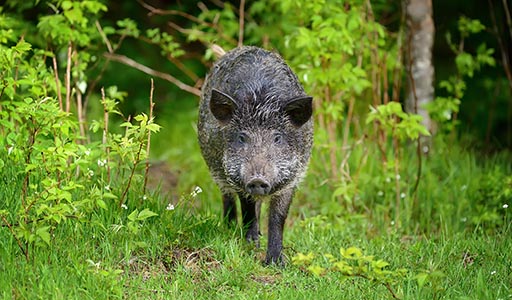Wild Hogs

Wild Hog Information
Feral pigs, or wild hogs, can do a lot of damage to a person’s property. They’ll eat practically anything that presents itself and can thrive in most any environment, which can become a problem when wild hogs decide to settle on your property. Hogs have a habit of rooting through yards in pursuit of food, and this search can quickly become destructive and completely decimate a lawn. If food isn’t disposed of properly or there’s a garden nearby, wild hogs may be attracted to the area. These pigs aren’t easy to get rid of either. They’re strong, fast, and resilient, and once they’ve settled in an area, deterring them is incredibly difficult. Trapping is the best solution, but this is a dangerous undertaking if you’re not a professional.

What does a Wild Hog look like?
Mostly black or brown, wild hogs are covered in thick, coarse hair that may also be red or dark gray, depending on their region. They have stout, barrel-like bodies with short and slender legs. Their faces are relatively long with a straight snout. Small, beady eyes and poor eyesight are also distinguishing characteristics.

What does a Wild Hog eat?
While wild pigs will eat almost anything that fits in their mouth, the opportunistic omnivores prefer plant products such as nuts, seeds, buds, and fruits. Insects, worms, small mammals, and the eggs of ground-nesting birds are also staples in their diet.

Wild Hog habitats
Originally, wild hogs were introduced in Florida, though they have since expanded their territory further west. As habitat generalists, the pests can live and thrive in virtually any environment. In addition, their high birth rates and long lifespans allow their populations to increase exponentially. Wild pigs are reported to live in at least 45 states.
Frequently Asked Questions
Available food has an effect on the color and texture of droppings. A wild hog diet that consists of acorns produces dark, hard scat with flakes of acorn shell visible inside. Fruit, like persimmons and plums, results in lighter, softer droppings that contain specks of red or black.
Attacks
Like most types of wildlife, these animals try to avoid people. However, because they can weigh well over 100 pounds and grow sharp tusks, wild hogs are dangerous to people in some cases. Attacks are rare, but the pests may charge at hunters or hikers if cornered or protecting their young.
Disease
In addition, wild hogs are dangerous due to the bacteria and viruses they carry. E. coli infection, brucellosis, and rabies can all transfer from feral pigs to humans or pets. Those who hunt and consume these animals are most at risk for wild hog diseases.


